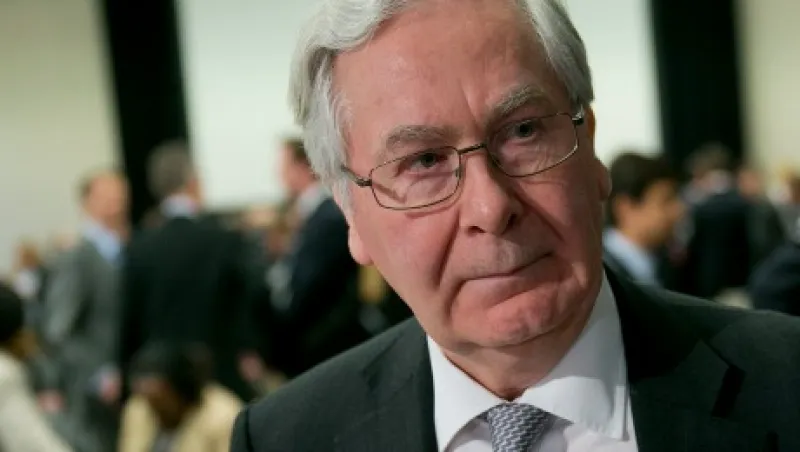Claudio Borio is getting anxious, and so are many investors.
Borio is little known outside central banking circles but very well known within them. As chief economist at the Bank for International Settlements, the Basel-based institution regarded as the central bank for central banks, he keeps a keen eye on financial market trends, and Borio doesn’t like what he’s been seeing lately.
Expectations about the future path of interest rates have fallen sharply this year in the U.S. and the euro area, spurring investors to embark on a frantic new search for returns. Yields on emerging markets have tumbled recently, with yields on ten-year dollar-denominated EM sovereign bonds falling by 80 basis points between February and late August, to 4.8 percent, according to the BIS’s latest quarterly review, released on Sunday. Spreads on high-yield bonds remain near record lows, notwithstanding a short sell-off in July. Volatility also remains extraordinarily subdued, despite a brief uptick at the end of July. In early September volatility gauges on long-term bond futures, equities, exchange rates and commodity futures stood close to, or below, the levels prevailing at the end of June 2007 — just before the subprime debt market blew up, triggering the global financial crisis.
“It all looks rather familiar,” Borio said of the market frothiness. Evoking the infamous words of former Citigroup boss Charles Prince back in July 2007, Borio said in a media briefing on the BIS review, “The dance continues until the music eventually stops. And the longer the music plays and the louder it gets, the more deafening is the silence that follows. Markets will not be liquid when that liquidity is needed most. And yet the illusion of permanent liquidity is just as prevalent now as in the past.”
Borio’s warning comes at a time when markets are showing signs of skittishness. Prices of U.S. Treasuries fell for a seventh straight day on Friday, September 12, the longest slump in more than a year. The yield on the ten-year Treasury closed at 2.61 percent, up 27 basis points from the late-August low and the highest level since early July.
Market participants will be watching closely for signs of a hawkish policy shift from the Federal Reserve Board when its policymaking Federal Open Market Committee meets this week. With the Fed on track to end its program of bond purchases next month and the economy and labor market showing signs of renewed strength in recent months, several Fed officials — including longtime dove Eric Rosengren of the Boston Fed — have recently called for the FOMC to abandon its promise to keep policy rates at zero for “a considerable time.” Some analysts have been advancing the date at which they expect the Fed to begin raising rates; Ethan Harris, chief economist at Bank of America Merrill Lynch, last week predicted the Fed would start hiking in June 2015, up from his previous forecast of September, because of solid economic growth and a continued recovery in housing prices.
“Removing ‘considerable time’ would be a big, hawkish shift,” Jan Hatzius, chief economist of Global Investment Research at Goldman Sachs, wrote in a September 12 note to clients. Hatzius doesn’t think the Fed will do so just yet because U.S. payroll employment and inflation have softened a bit recently. The three-month average rise in nonfarm payrolls slowed to just over 200,000 in August from about 250,000 in June, he noted, whereas the Fed’s favorite inflation metric, core PCE inflation, has dropped back below the Fed’s 2 percent target on a three-month annualized basis. And notwithstanding the growing murmurs of dissent within the Fed, the FOMC remains strongly in the grip of doves led by Fed chair Janet Yellen and New York Fed president William Dudley.
Analysts fixate on the Fed because its zero-rate policy and quantitative easing have been the biggest factors sustaining global asset prices for nearly six years, and a shift in stance would be momentous. According to analysts at Bank of America Merrill Lynch, 45 percent of the world’s outstanding government bonds currently yield less than 1 percent, and 81 percent of the world’s equity market capitalization is supported by zero-rate policies. When the Fed shifts, the market reaction could be dramatic, as last year’s so-called taper tantrum demonstrated.
Priya Misra, head of U.S. rates strategy at BofA Merrill, predicts that the yield on the ten-year Treasury will rise to 3.1 percent at the end of this year and 3.75 percent at the end of 2015. If that forecast is accurate, that implies a total return loss of 4 percent on the ten-year bond at the end of this year and a loss of 6.7 percent at the end of 2015. For a security that has enjoyed a 30-year bull run and has been one of the star performers since the crisis, such losses would be dramatic.
It’s not just Treasuries and U.S. equities that would be affected by a shift in Fed policy. According to the BIS report, cross-border lending to emerging-markets economies grew by $166 billion, or a 10 percent rate, in the first quarter of this year. Bond issuance by EM corporations, particularly foreign currency debt, has risen sharply too and now approaches a total of $2 trillion outstanding, the BIS states. “If there is a rush for the exit by bond investors that shuts down the market, as happened briefly during the taper tantrum last year, this could make it more difficult to refinance maturing debt, rather than less,” cautioned Hyun Song Shin, head of research in the BIS’s monetary and economic department.
As the day of a Fed policy shift draws nearer, the risk of financial turmoil appears to be growing. As Borio put it, “A common mistake is to take unusually low volatility and risk spreads as a sign of low risk when, in fact, they are a sign of high risk-taking.”






